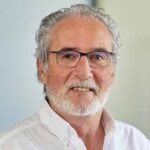
AZTI
«The good practices code is a great project to reduce the undesired effects of fishing to the maximum.»

Josu Santiago
Coordinator of the Tuna Management Area at AZTI
AZTI
One of the most important aspects in achieving a more sustainable fishing sector is creating synergies, i.e. the fleet collaborating with science, science going hand-in-hand with institutions, and for public bodies to make an effort to find out what the sector professionals need. “Teamwork”: something AZTI knows a lot about. This scientific and technological centre, specialised in marine environments and food, provides cutting-edge and value-added products and technologies based on sound science and research.
Josu Santiago is the Tuna Management Area co-ordinator at AZTI. Specialised in tuna population biology and dynamics, he claims: “there are many scientific activities and projects which respond to these research priorities of the international fishing organisations in terms of improving knowledge about biology, reproduction, migrations, and of improving the models used to understand the dynamics of said populations. A lot of the research and work we do at AZTI is directed towards this end”.
The conclusions of an AZTI study were published a few weeks ago which reveals tuna will be 15% smaller in 2050, and their stock reduced by 36% due to fishing pressure and global warming. What exactly are these consequences?
Firstly, it should be pointed out that these kinds of studies work with climate models and, as such, they correctly reflect trends, although their results in quantitative terms should be viewed with caution. So, that’s my first message, i.e. to clarify we’re talking about the general trends indicated by said models; however, the message in quantitative terms is something else. Secondly, in this case, the impact of climate change as indicated in these models varies according to the species and ocean in question. The aim is to make public what these models reflect regarding trends but not to convey alarm.
Of the world's tuna catches come from stocks of healthy stocks
Are we aware of this reality? Are steps already being taken in an endeavour to prevent these forecasts from coming true?
Many things are being done. First of all, tuna resources worldwide are regulated via several bodies, i.e. regional fishing organisations, which are critical in regulating fishing activities around the globe. There are 5: a smaller one that is focused on a single species, the southern bluefin tuna, whose acronym is CCSBT; and a further 4 which are important and whose decisions affect the fleets located in Bermeo. These are ICCAT, the Atlantic one; IOTC, the Indian Ocean one; and 2 committees in the Pacific, namely the CIAT and WCPFC. These organisation have a scientific council “using” science to advise agents via different committees. Well, these committees are adopting measures for tuna fishing management worldwide and are ever more aligned with the management scientific council. Many things are being done and it’s essentially via these regional tuna fishing organisations and committees.
In other words, are we on the right road?
Yes, we’re on the right road. Another important message is that right now 87% of all the tuna caught worldwide is from healthy population stocks, i.e. right now 10%-15% require measures so those populations can somehow recover optimum conditions. We mustn’t lose sight of the fact 87% of these tuna catches worldwide use healthy resources, so the aim of these committees is to continue working till we achieve 100% healthy actions, not remain in 87%, and not only in terms of tuna populations but also the environment and the ecosystems tuna lives in.
The basque fleet is a pioneer when it comes to promoting and adapting to sustainability seals
What’s the role of the Basque fleet on this road towards sustainable fishing?
In some ways the Basque fleet has been pioneering in terms of boosting and adapting to the sustainability labels. It was the first or at least one of the first at state level in obtaining the MSC label for the North Atlantic albacore tuna. Moreover, it’s a strong fleet since it’s responsible for approximately 10% of the world tuna catches, chiefly from Bermeo vessels, so its prominence in world fishing activity is frankly important. In terms of what this fleet is doing, they’re the parties most interested in ensuring sustainability. They’re clear about the fact it’s their future, and there are multiple initiatives directed towards that goal. For example, their very close collaboration with science (both with us and other international scientific bodies). They were pioneers when supplying highly relevant data, e.g. about the depth sounders used in their fishing, about catches, etc., i.e. basic information enabling us scientists to carry out quantitative evaluations to diagnose the status of the resources. Furthermore, this fleet has been pioneering in agreeing a code of good practices of compulsory compliance for incorporation in their activity, all the companies and vessels. To what end? This fleet frequently uses the so-called FADs, which are fish aggregating devices. This code established and continues to establish the references for using these devices, e.g. they mustn’t be in entangling nets to avoid unwanted catches, or they are also working on incorporating biodegradable materials to reduce the impact of contaminants on the ocean, the impacts on sensitive habitats, etc. In conjunction with us, they’re supporting and incorporating measures and instruments to reduce mortality when releasing sensitive species like: turtles, sharks, or manta rays. They’re also doing extraordinary work there incorporating devices which are considerably reducing the undesired effects of any fishing activity.
Different projects
What are the main projects or initiatives AZTI is working on in this area?
One of the large projects is identifying and incorporating good practices in the fishing activity to mitigate and reduce undesired effects to the maximum. There are also various projects working on mitigating effects, e.g. one of the species which appears most frequently as an accessory catch is the so-called silky shark, and we are undertaking marking tasks. Why? Well, we’re implementing two types of markers, one informing about survival, i.e. we apply an electronic marker which must be released at 60-90 days depending on how it is programmed. If released earlier, then the animal is dead; however, if the marker continues emitting after 60 days it means it’s been released as per its programming. This enables us to evaluate the survival enhanced thanks to these good practices. We’re also marking species with other electronic markers which constantly collect information such as temperature or pressure over depth, and have light sensors that together with time, can report positions and so we are able to track the entire trajectory of the animal. This allows us to build what are called habitat models and better understand the behaviour and biology of these animals. Another project also linked to good practices is the incorporation of what we call Hopper, which is basically a hopper located in the vicinity of the unloading hatch of the vessels, over which the fish is dumped, allowing us to release unwanted catches in a more optimal way and reduce their mortality. It is a project with an important impact as it is being incorporated in quite a few units. And we have other projects with the industry to evaluate the impact of FADs on the ecosystem, in particular in what would be sensitive areas such as coral areas, etc. As well as multiple other initiatives.




